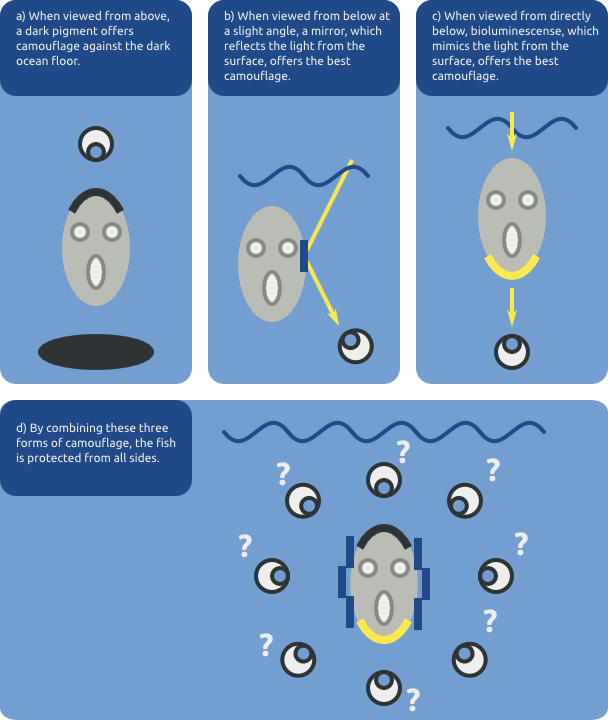I don't remember when I first saw a video of an octopus's amazing camouflaging abilities, but I know that I've been fascinated ever since.
Its not just the octopus that is a master of disguise, though. Pressured by the unique challenges of marine life, many marine animals have evolved elaborate forms of camouflage. Prime examples of this can be found in the twilight zone, the colloquial term for the oceanic zone that lies a few hundred meters beneath the surface. Because of the three-dimensional nature of their aquatic environment, it is extremely difficult for animals in the twilight zone to camouflage themselves properly: When viewed from below, they need to blend in with the (relatively) bright surface. When viewed from above, they must blend in with the dark ocean floor, or the equally dark depths. A singular form of camouflage will simply not do!
In response to this challenge, many "twilight fish" have evolved multiple, complementary forms of camouflage. To be hidden when viewed from above, they tend to have a darkly pigmented back that avoids standing out against the oceanic darkness below (a in the figure). Another, more ingenious form of camouflage is provided by silvery, reflective sides (b). These function as mirrors that reflect light from the surface, thus providing near invisibility when viewed from below at a slight angle. Obviously, having a dark back or reflective sides offers little protection when viewed from directly below. To be invisible from this angle as well, these fish employ a third form of camouflage: a bioluminescent belly, essentially a biological light bulb that points downward and matches the brightness of the surface (c). Taken together, a dark back, reflective sides, and a bioluminescent belly provide the fish of the twilight zone with adequate camouflage from all sides (d).

But Zylinski and Johnson report, in a recent issue of Current Biology, that mid-water camouflage gets even more remarkable.
In their study, they investigated the camouflaging abilities of two species of squid. Most of the time, these squid are transparent. Perfect transparency is obviously the best form of camouflage, but transparency is never perfect. For one thing, eyes and intestines are generally opaque, which is a problem. Another problem is that the interface between the squid's body and the water causes considerable bending and scattering of light. This is inevitable when different substances meet (squid and water, in this case), and would occur even if the squid was perfectly transparent.
The more light there is, the more problematic these issues become. Transparency is effective when there is little light, which is the typical situation far below the ocean surface. But it is much less effective when put in a spotlight that reveals all imperfections. And although you might think that spotlights are rare in the ocean, they are not. There are quite a few fish that search for prey using bioluminescence: These hunters are their own spotlight.
Zylinksy and Johnson wondered how the naturally transparent squid would respond to a sudden exposure to light, which could potentially blow their cover. What they found is quite striking, as you can see in the video below. Even a short exposure to light causes the squids to become opaque.
It seems, therefore, that these squid adopt the optimal form of camouflage, depending on the situation. Usually they are transparent, which is effective in their dimly lit oceanic environment. But in response to a sudden beam of light, which will usually be accompanied by a sharp row of teeth, they lose their transparency and adopt a dark colour to blend in with their surroundings.
References
Land, M. F., & Osorio, D. C. (2011). Marine optics: Dark disguise. Current Biology, 21, R918-R920. doi:10.1016/j.cub.2011.10.009
Zylinski, S., & Johnsen, S. (2011). Mesopelagic cephalopods switch between transparency and pigmentation to optimize camouflage in the deep. Current Biology, 21, 1937-1941. doi:10.1016/j.cub.2011.10.014